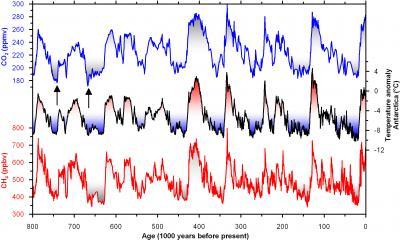|
Related Topics: |
|
Current News |
|
Chemistry A to Z |
|
About Internetchemistry |
|
- Imprint |
|
|
Ice cores reveal fluctuations in the Earth's greenhouse gases |
|
The results obtaines in the framework of the European Project for Ice Coring in Antarctica (EPICA) run by a consortium of 10 European Nations among them the Niels Bohr Institute at University of Copenhagen are being published in two articles in the respected scientific journal Nature. An ice core drilled through the three-kilometre-thick ice cap at the EPICA Dome C Station in the middle of Antarctica reveal the climate 800,000 years back in time – through eight glacial periods and eight interglacial periods. The glacial periods last 100,000 years on average, and the warm interglacial periods – such as the one we are now in – last an average of 10,000 years. |
|
The ice is formed by snow falling year after year and which, with time, is compressed to form a thick ice cap. The ice contains atmospheric air, and the annual layers provide information about the climate in the years in which the snow fell. The mix of water isotopes in the ice reveals the temperature, and analyses of the entrapped air show the atmospheric content of gases such as carbon dioxide and methane. Extremely low CO2 content “The temperature curve over the past 800,000 years matches the CO2 curve beautifully – during glacial periods in which the climate is cold, there is less CO2 in the atmosphere,” says Professor Thomas Blunier from the Centre for Ice and Climate at the Niels Bohr Institute, University of Copenhagen. He explains that when it is cold there is less plant growth, and so there are fewer plants to absorb the CO2 from the air, while more CO2 is absorbed in the oceans, so the final calculation is a low CO2 content in the atmosphere during glacial periods. This produces a lower greenhouse effect, and leads to an even colder climate. However, the new results show that during the glacial period that occurred between 650,000 and 750,000 years ago, the CO2 level was extremely low – lower than any previous measurements have indicated. It happened twice in this period, while the temperature was not lower than during other glacial periods. Drop in sensitive greenhouse gases Methane, CH4, is a another important greenhouse gas and a sensitive indicator of climate changes and temperature fluctuations. Methane is formed by microorganisms and escapes from natural gas reservoirs. The biggest discharge from nature comes from bacteria in marsh areas which contribute 70 per cent of the air’s methane content, while the remainder comes mostly from wild animals. Analyses of the ice cores from Antarctica show that the curve for methane matches the temperature curve – when the climate is cold, there is less methane in the atmosphere. The measurements indicate a strong relationship between the atmospheric methane content in relation to the Earth’s path around the Sun as well as the inclination and direction of the Earth’s axis. They find evidence for an increasing strength of the monsoon circulation in the tropics over the past 400,000 years. For the first time, scientists have now produced a complete set of data showing measurements of methane going back 800,000 years. The new measurements from the EPICA Dome C ice cores show also that some climate changes are happening faster than those resulting from the long-term cycles in space. About 770,000 years before now, scientists have identified rapid changes in the amount of both CO2 and CH4 in the atmosphere. These are very fast changes which have occurred within just a few decades. The dramatic changes indicate that climate changes can take place very quickly. Similar changes took place about 40,000 years ago during the last glacial period. Today, emissions from nature only account for a small amount of the methane found in the atmosphere. Current concentrations are 124 per cent higher than in previous periods, and this is largely due to domestic animals, agriculture and fossil fuels, so the high level is indirectly the result of man’s activities. The concentration of CO2 is 28 per cent higher than before the Industrial Age. And which process might this trigger"? By analysing historical climate data, scientists will be able to better predict the climate-produced consequences of global warming. |
|
|
|
|
Related topics - search form: |
|
|
